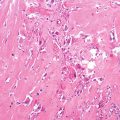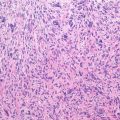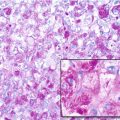Localization: Preferred sites are long bones, particularly the distal femur and proximal tibia. Rare in flat bones, exceptional in the hands and feet. It is usually centered in the metaphysis and, as it occurs mostly in the adults, it usually involves the epiphysis too.
Clinical: Mild to moderate pain and, less frequently, a moderate swelling. Clinical history is often of long duration. Pathologic fracture is rare.
Imaging: Usually, due to the slow course, tumors are large. The lesion appears mixed, lytic, and blastic. Even when lytic, some ground-glass density can usually be found. Conversely, when it is sclerotic, some radiolucent areas are usually present. The bone contour may be expanded with a thin cortex that may present some discontinuity. In half of the cases, a soft tissue mass can be found, which can be either radiolucent or densely mineralized. Frequently, the tumor presents a coarse trabeculation similar to desmoid tumor of the bone. A chronic periosteal reaction and thickening of the cortex are occasionally observed. Isotope scan is hot. CT and MRI are essential to define the extensions of the tumor.
Histopathology: Spindle cells producing collagen and bone. The tumor closely mimics the histological pattern of parosteal OS. When osteogenesis is scarce, the tumor is similar to desmoid tumor or low-grade fibrosarcoma. Less frequently, it has the “Chinese characters” appearance of fibrous dysplasia. Occasionally foci of cartilage can be seen. The cells demonstrate slight atypia with few mitotic figures. Osteocytes of the bone trabeculae are normal. The grade is either 1 or 2. Almost regularly, the tumor has a permeative pattern.
Course and Staging: The course is slow. In about 15 % of cases, the tumor shows a progression of malignancy, transforming into a high-grade OS. The stage of the tumor is I-A or I-B. Transformed tumors become stage II.
Treatment: Intralesional or marginal excision is almost regularly followed by local recurrence. Thus, surgery must obtain wide margins, which is usually feasible with conservative resection. Chemotherapy is not indicated, except in case of progression in malignancy.
Prognosis: Mets (lungs) are reported in 10 % of cases and mostly in tumors that progressed in malignancy. They can occur many years after the onset of symptoms. Thus, prognosis is good, unless the tumor becomes a high-grade OS.







